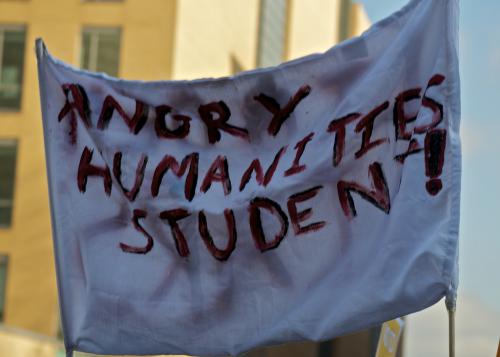
Image Credit:
There’s nothing quite like having twenty-one angry people gathered in a small windowless room—especially when they’re all angry at you. Now I know to expect (and to look forward to!) just such a class day when I teach Jamaica Kincaid’s 1988 essay A Small Place.
When I initially planned the syllabus for my course, Rhetoric of Tourism, I included Kincaid’s text for remarkably straightforward reasons: it makes an argument about tourism; it deploys a number of different rhetorical strategies to make its argument; and it influenced me tremendously when I first read it for an undergraduate class. And from the beginning, I knew that A Small Place would trigger a strong reaction from my students. The essay opens by critiquing tourists in Antigua, calling them “ugly,” “stupid,” “pastrylike-fleshed,” and so forth; it goes on to draw connections between the colonization of Antigua and the contemporary tourism industry.
In teaching A Small Place, however, I’ve been struck both by the degree of emotion it has provoked in my students, and the differences in their reactions each semester. Last fall, (most of) my students were genuinely offended by Kincaid’s argument. Substantial portions of the text use the second person voice, identifying the reader herself as the “ugly” tourist. Many students either became angry at the text’s accusations (“But I’m not like that! She can’t assume!”) or ashamed (“This makes me never want to travel again!”).
From a pedagogical point of view, there were some real benefits to these responses. We could discuss tone (would the argument have been more effective if it had been gentler on its audience?), distinguish types of appeals (they were all on board with her reasons, but the emotional appeals overwhelmed many students), delve into a nuanced ethos analysis (as an Antiguan, Kincaid is credible, but she seems to have little regard for her audience), etc. At the same time, however, their strong feelings also created obstacles. Some students did not want to finish reading the essay, for example, while others insistently attempted snarky, defensive commentary throughout the class discussion.
Following that experience, I still felt that the pros of teaching A Small Place outweighed the cons, so I included it again on my spring syllabus. To my surprise, however, my second group of students was far less upset by the essay. “She makes a lot of good points,” they said, and, “If I were in her position, I would probably feel the same way.” Despite their less hostile initial reactions, our subsequent discussion annoyed this class in a different way.
After a brief opening discussion, I asked the students to create a single sentence that summed up Kincaid’s main thesis in the essay. (I had my previous class do the same, but I had been much less intent on getting them to cut their ideas down to a single sentence.) They brainstormed as a class, and then I broke them into small groups to construct thesis statements. I gathered their proposed sentences, posted them at the front of the room, and asked them all to vote on which group’s thesis statement most effectively conveyed Kincaid’s argument. I also said that they could revise particular words or phrases within the four or five suggested candidates for “best sum-up of Kincaid’s thesis.” I imagined that this exercise would take twenty minutes at most.
Instead, it took about an hour, and the class was still far from satisfied with the “final” thesis statement. There were definitely some productive aspects of this apparently maddening exercise: students were forced to boil down a lengthy and nuanced argument into a concise sum-up, and the contrasts among the groups’ proposed sentences sparked a thoughtful sub-conversation. (The students’ debate over whether Kincaid’s argument focuses on “tourists” or “tourism,” for instance, was a high point.) That said, the exercise was deeply frustrating for many students; by the end, some were too tired of the activity to care anymore, while others could not stop tweaking the sentence by questioning word choices and orders, which led to some minor bickering.
All this is to say that I’ve used the same text to make two different classes angry in two different ways, and despite some small setbacks, I believe it’s been worth it. Sometimes students’ anger or annoyance isn’t productive, like when they are too wrapped up in their emotional reactions to follow the assigned reading, or when they snap at each other over a verb tense choice. That said, having students cope with demanding material forced them to confront emotional hurdles, difficulties with information synthesis, and other important personal and academic challenges. Moreover, these endeavors—I like to think—also helped them to grow together as a class. I suspect that intentionally making a class mad isn’t for everyone, and it certainly shouldn’t be a weekly activity. But it’s at least worth trying.

